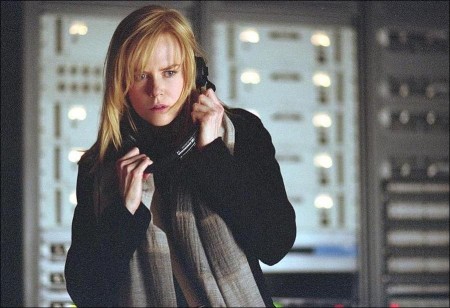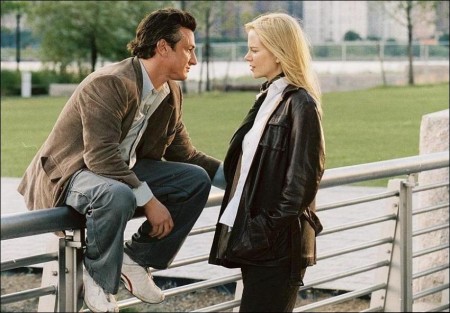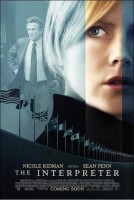Tagline: The truth needs no translation.
From Academy Award winner Sydney Pollack, the director behind some of the most compelling and provocative thrillers of the last two decades (Three Days of The Condor, Absence of Malice, The Firm), comes a fresh take on contemporary suspense: an intricate, knife’s-edge drama that unfolds against our 21st Century world of international terror and inside the United Nations’ hidden corridors of power.
Academy Award winners Nicole Kidman and Sean Penn star in The Interpreter, the story of two opposite people who unexpectedly collide within a maze of mounting paranoia, personal secrets and explosive global events. Shot on location in Manhattan and Southern Africa, The Interpreter is the first motion picture in history to receive inside access to the United Nations’ headquarters (which is officially international territory) in New York.
The escalating events begin when African-born U.N. translator Silvia Broome (Nicole Kidman) alleges that she has overheard a death threat against an African head of state, spoken in a rare dialect few people other than Silvia can understand.
With the words “The Teacher will never leave this room alive,” in an instant, Silvia’s life is turned upside down as she becomes a hunted target of the killers. Placed under the protection of federal agent Tobin Keller (Penn), Silvia’s world only grows more nightmarish. As Keller digs deeper into his eyewitness’ past and her secretive world of global connections, the more suspicious he becomes that she herself might involved in the conspiracy. With every step of the way, he finds more reasons to mistrust her.
Is Sylvia a victim? A suspect? Or something else entirely? And can Tobin, coping with his own personal heartache, keep her safe? Though they must depend on one another, Silvia and Tobin couldn’t be more different. Silvia’s strengths are words, diplomacy and the subtleties of meaning, while Tobin is all about instinct, action and reading into the most primal human behaviors.
Now, as the danger of a major assassination on U.S. soil grows and Silvia’s life hangs in the balance, Silvia and Tobin play out a gripping dance of evasion and revelation that keeps them both guessing as they race to stop a terrifying international crisis before it’s too late.
Setting a Story of Suspense Inside the United Nations
In the power-brokering halls of today’s United Nations-where wars, disasters and global crises are addressed and sometimes averted on a regular basis-every single word counts. No one knows this better than the U.N.’s highly trained, language-savvy interpreters, who spend their days in soundproof booths making sure the carefully chosen speeches of world leaders aren’t misunderstood as they negotiate peacemaking deals that will affect the lives of millions.
Usually, interpreters simply listen and translate. They are forbidden from getting involved. But what if an interpreter heard a secret so incendiary, so threatening to the world, that she couldn’t keep it confidential? And what if she knew beyond a shadow of a doubt that by revealing the threat, her own life would be in mortal danger?
This gripping scenario became the jumping-off point for Sydney Pollack’s newest take on the high-intensity, thought-provoking thriller, The Interpreter, which pairs a classic, ticking-clock story of two people caught up in a conspiracy beyond their control with timely themes of global interconnectedness, rogue terror, the dangers of misinterpretation and the compelling need to speak the truth.
For Pollack-who has previously plunged into the fearsome, high-stakes world of a run-away CIA operation in Three Days of the Condor starring Robert Redford and Faye Dunaway; explored love, vengeance and the power of the media in Absence of Malice with Paul Newman and Sally Field; and exposed the dark and savage side of becoming a corporate lawyer in The Firm, starring Tom Cruise and Gene Hackman-The Interpreter appeared to have all the immediacy, complexity and emotional veracity of a political thriller for our time.
Says Pollack, “I was attracted to The Interpreter for a number of reasons. The inner workings of the U.N. and the diplomatic world seemed to be truly fresh, and remarkably apt, terrain at the moment. This setting exposes the personal conflicts between Silvia and Tobin, two characters who come from opposing points of view and can’t, at first, seem to overcome the obstacles between them. A sophisticated, international woman who truly believes in the art of diplomacy, in words over violence, who bumps into a cop who deals with the most ugly and base side of human nature. The improbability of these two people coming together inside the context of a potentially explosive international situation and having to solve a mystery under intense time pressure-this seemed like rich material for a film to me.”
Pollack was terribly disappointed when he learned that no motion picture had ever been shot within the inner sanctum of the United Nation’s majestic home on the east side of Manhattan, which despite its intricate role in the modern world, has remained off-limits to movie cameras since its founding. Even Alfred Hitchcock was rejected when he requested to shoot scenes of the classic North By Northwest inside and the master of the suspense-thriller wound up mocking up the famous visitor’s lounge as a set for his film. But through an extraordinary diplomatic mission of his own, Pollack was able to negotiate unprecedented access so that The Interpreter could reveal a part of the world’s power structure never before seen on-screen.
Says Charles Randolph, who together with Scott Frank and Steven Zallian, wrote the film’s multifaceted screenplay, “The U.N. is really the perfect setting for creating the kind of international intrigue usually associated with classic films, such as those by Hitchcock, in today’s world. Decisions made in the corridors of power at the U.N. have a huge impact around the world and right now, the stakes are higher than ever, which makes it an extraordinary place for two ordinary, vulnerable people to become caught up in a conspiracy that seems vast but that they must somehow stop.”
The concept for The Interpreter first emerged from the imaginations of producer Eric Fellner and Tim Bevan of production company Working Title Films. They wanted to set a story inside the realm of international diplomacy, where one person’s actions-or words, for that matter-can impact people on the other side of the globe. Recalls Bevan, “Eric and I initially had the idea years ago of an interpreter, of someone who exists in this rarified world of statesmen and politicians, who suddenly finds herself through accidental circumstances in the position of being able to change the course of something that is going to happen in the world. The idea never went away and it became increasingly relevant.”
Initially, Kevin Misher, at the time the president of production of Universal Pictures, had himself been casting about for a politically based thriller in the vein of some of the classic Hitchcockian tales of intrigue and turn-of-the-screw plot twists. Misher had approached Bevan and Fellner, “Because I was hopeful they would have something like this in their library. I had envisioned a story as a thriller in the long-standing tradition of great films that mix menacing suspense with insights into political reality. The brilliant idea of setting it inside the U.N. made it too good to pass up.” Working Title presented their story idea…and the project began to take shape.
During the time the film began to move forward, Misher had left his studio post to become an independent producer; when Fellner and Bevan offered to continue working with him in his capacity as producer, Kevin immediately signed up.
Relates Misher, “As a producer and a born-and-bred New Yorker, it was an opportunity to actually make a movie like the classic New York thrillers of the `70s that I had grown up on. When Tim said, `Listen, let’s do this film together,’ I jumped at the chance.”
Right from the beginning, the production team attempted to involve the United Nations, making a research trip before the screenplay was even started. “We met with security officers, staff members and interpreters and we were also given an extensive tour of the building, which was all very inspiring,” recalls Misher. “One thing that really impressed us, and that we wanted to get into the film, is how dynamic and relevant the U.N. is in today’s globally connected world. It’s an amazing place for an outsider to get to see from the inside.”
At this point, the quest for a director also began. For the producers, Sydney Pollack had been a top choice right from the beginning-and were blessed when the Oscar-winning filmmaker had read the script independently and contacted the producers to set up a meeting.
“I remember Sydney came into the room in a very self-effacing way, talking about this thriller Three Days of the Condor he had made many years ago-and of course we recognized it as a model of the type of film we aspired to make. Then he began talking in-depth about The Interpreter, presenting his ideas about how a good thriller is constructed and how escalating suspense and intrigue are woven into the fabric of a human story. We saw immediately that he knew the material inside out and already had a lot of terrific ideas about how to make it vital to today’s audience,” recalls Misher.
Pollack began to collaborate with the screenwriters and immersed himself in research into United Nations procedures, the lives of interpreters and African politics.
Early on, a decision was made to have both the character of Silvia Broome and the threatened head of state hail from an entirely fictional African country rather than use a real nation about which audiences would already have an impression. Pollack explains, “We didn’t want to use an existing country because it would run the risk of becoming too much like a documentary instead of a fictional thriller. But we were careful to be as authentic as possible in creating a reality-based history and believable language for our fictional country so that it feels as if it actually exists.”
Named “Matobo” by Charles Randolph, the country was created as a sub-Saharan nation in Southern Africa in the vicinity of Zimbabwe and Mozambique, two countries that, while not models for Matobo, have each had their own struggles with strife and war. Randolph imagined an entire political reality for the made-up country based on Southern Africa’s modern history, involving post-colonial struggles, warring tribal factions and institutionalized corruption. Then, working with linguists, the filmmakers helped to forge an imaginary language for Matobo, dubbed “Ku,” that would sound entirely real to most ears.
Sydney Pollack explains, “We went to a language center in England and worked with a professor there to develop a tongue that’s a cross between Swahili and Shona, two common African languages in Eastern and Southern Africa. This new language, Ku, has elements of both of those languages, along with a number of unique elements…and Nicole Kidman had to become fluent in this tongue that doesn’t truly exist.”
While using a fictionalized African country served the film’s tightly woven story, when it came to capturing the extraordinary inner world of the U.N., Pollack wanted as much authenticity as possible. After being handed the customary veto on movie cameras inside the U.N., Pollack did not give up. Through a series of connections, he was able at last to speak directly to General Secretary Kofi Annan to ask for permission to shoot inside the United Nations building.
“One of the reasons I was so attracted to The Interpreter is that it was an opportunity to shoot inside the United Nations and I naively assumed at the start that we were going to have that privilege,” recalls Pollack. “Then we learned that no one is allowed to bring movie cameras into the U.N., and there has never been any exception made before. Our start date was approaching, so we began to prepare for using miniatures and computer-generated images. But I was upset by the whole notion and I felt we had to make at least one more effort. So few Americans have ever seen the inside of the United Nations, or really know what goes on in there, and we were excited to reveal that. I started calling anybody and everybody that I knew who had any connections and eventually I was able to arrange a meeting with Kofi Annan.”
Key to arranging the make-or-break meeting was the United Nations Under Secretary-General for Communications and Public Information, Shashi Tharoor, who became an enthusiastic supporter of the film. Tharoor felt it was time to make an exception to the old rule in these new times.
“Our organization has had a restrictive policy in the past, but I felt some of those decisions were not terribly wise because the U.N. is an institution we need to demystify a little bit,” Tharoor explains of his decision to approach Annan. “We’re an organization of governments but we work for the peoples of the world, and I think it’s important to make the U.N. more accessible to those people.
“The basic story of The Interpreter seemed to me to showcase the values that this institution stands for,” he continues. “Of course, when a person of Sydney Pollack’s eminence approaches us, it seems that it’s giving the U.N. the kind of respect that a lesser filmmaker might not have brought to it. So our thinking became very clear.”
Annan was also intrigued by Pollack’s proposal but Pollack was honest about his intent. The director explains, “I wanted to be very clear with him that I wasn’t going to make an advertisement for the U.N.-that this was an entertainment that creates a fictional world. At the same time I told him that the main character who Nicole Kidman plays is someone passionately devoted to the principles of the U.N., that Silvia Broome is someone who grew up with terrible political violence and opted for a life of diplomacy. I explained that it is a story about using words over gunfire. I wanted it to be an argument about words versus guns. It was a good meeting.”
In the end, Annan gave his green-light to the production-but only after going before the powerful, 15-member Security Council to get their permission as well-and Pollack was afforded the first ever access to such vaunted rooms as the General Assembly, usually only seen on the television news during major world events. “It’s an atmosphere that can’t be re-created in any other way than being there,” sums up Pollack.
These production notes provided by Universal Pictures.
The Interpreter
Starring: Nicole Kidman, Sean Penn, Max Minghella, Catherine Keener, Jesper Christensen
Directed by: Sydney Pollack
Screenplay by: Charles Randolph, Scott Frank, Steven Zaillian
Release Date: April 22nd, 2005
MPAA Rating: PG-13 for violence, some sexual content,language.
Studio: Universal Pictures
Box Office Results
Domestic: $72,708,161 (44.6%)
Foreign: $90,236,762 (55.4%)
Total: $162,944,923 (Worldwide)




